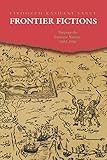Frontier Fictions : Shaping the Iranian Nation, 1804-1946 / Firoozeh Kashani-Sabet.
Material type: TextPublisher: Princeton, NJ : Princeton University Press, [2014]Copyright date: 2000Edition: Core TextbookDescription: 1 online resource (328 p.) : 10 line illusContent type:
TextPublisher: Princeton, NJ : Princeton University Press, [2014]Copyright date: 2000Edition: Core TextbookDescription: 1 online resource (328 p.) : 10 line illusContent type: - 9781400865079
- Geographical perception -- Iran
- Nationalism -- Iran -- History -- 19th century
- Nationalism -- Iran -- History -- 20th century
- ARCHITECTURE / History / General
- Abbas Mirza
- Activism
- Afghanistan
- Agriculture (Chinese mythology)
- Ahmad Kasravi
- Amir Kabir
- Annexation
- Arabs
- Azerbaijanis
- Balochistan, Pakistan
- Cartography
- Central government
- Civilization
- Constitutionalism
- Constitutionalist (UK)
- Culture of Iran
- Despotism
- Disenchantment
- Fereydun
- Geography of Iran
- Governance
- Ideology
- Imperialism
- Iranian nationalism
- Iranian peoples
- Karbala
- Khuzestan Province
- Kirmani
- Kurds
- Literature
- Majlis
- Manifest destiny
- Militarization
- Mirza
- Modernity
- Mushir
- Narrative
- Nasir al-Din
- Nation state
- Nationality
- Newspaper
- Nusrat
- Ottoman Empire
- Patriotism
- Persian language
- Persian people
- Persianization
- Politician
- Politics
- Power politics
- Qajar dynasty
- Qajars (tribe)
- Republicanism
- Reza Shah
- Russians
- Safavid dynasty
- Sayyid
- Separatism
- Shahnameh
- Sheikh
- Sistan
- Sovereignty
- Suzerainty
- Tabriz
- Tax
- The Other Hand
- Treaty
- Warfare
- Writing
- Zoroastrianism
- 955.05 23
- DS299
- online - DeGruyter
| Item type | Current library | Call number | URL | Status | Notes | Barcode | |
|---|---|---|---|---|---|---|---|
 eBook
eBook
|
Biblioteca "Angelicum" Pont. Univ. S.Tommaso d'Aquino Nuvola online | online - DeGruyter (Browse shelf(Opens below)) | Online access | Not for loan (Accesso limitato) | Accesso per gli utenti autorizzati / Access for authorized users | (dgr)9781400865079 |
Browsing Biblioteca "Angelicum" Pont. Univ. S.Tommaso d'Aquino shelves, Shelving location: Nuvola online Close shelf browser (Hides shelf browser)

|

|

|

|

|

|

|
||
| online - DeGruyter Ideas and Mechanism : Essays on Early Modern Philosophy / | online - DeGruyter The New Map of the World : The Poetic Philosophy of Giambattista Vico / | online - DeGruyter A Source Book in Indian Philosophy / | online - DeGruyter Frontier Fictions : Shaping the Iranian Nation, 1804-1946 / | online - DeGruyter A Perilous Progress : Economists and Public Purpose in Twentieth-Century America / | online - DeGruyter Income Distribution in Macroeconomic Models / | online - DeGruyter Alan Turing: The Enigma : The Book That Inspired the Film The Imitation Game - Updated Edition / |
Frontmatter -- Contents -- Illustrations -- Acknowledgments -- Chronology of Major Events -- Glossary -- Introduction. Frontier Fictions -- 1. A Manifest Destiny Diverted, 1804-1896 -- 2. Limning the Landscape: Geographical Depictions of the Homeland, 1850s-1896 -- 3. From Riches to Ruins: The Political Economy of Frontiers, 1897-1906 -- 4. Political Parables: Iran's Frontier Crucible, 1906-1914 -- 5. Coercing Camaraderie: The War, the Military, and the Myth of Riza Khan, 1914-1926 -- 6. Parenting Little Patriots: Domesticating the Homeland, 1921-1926 -- Conclusion. What's in a Name? From Persia to Iran, 1926-1946 -- Notes -- Bibliography -- Index
restricted access online access with authorization star
http://purl.org/coar/access_right/c_16ec
In Frontier Fictions, Firoozeh Kashani-Sabet looks at the efforts of Iranians to defend, if not expand, their borders in the nineteenth and early twentieth centuries, and explores how their conceptions of national geography influenced cultural and political change. The "frontier fictions," or the ways in which the Iranians viewed their often fluctuating borders and the conflicts surrounding them, played a dominant role in defining the nation. On these borderlands, new ideas of citizenship and nationality were unleashed, refining older ideas of ethnicity. Kashani-Sabet maintains that land-based conceptions of countries existed before the advent of the modern nation-state. Her focus on geography enables her to explore and document fully a wide range of aspects of modern citizenship in Iran, including love of homeland, the hegemony of the Persian language, and widespread interest in archaeology, travel, and map-making. While many historians have focused on the concept of the "imagined community" in their explanations of the rise of nationalism, Kashani-Sabet is able to complement this perspective with a very tangible explanation of what connects people to a specific place. Her approach is intended to enrich our understanding not only of Iranian nationalism, but also of nationalism everywhere.
Mode of access: Internet via World Wide Web.
In English.
Description based on online resource; title from PDF title page (publisher's Web site, viewed 20. Nov 2024)


